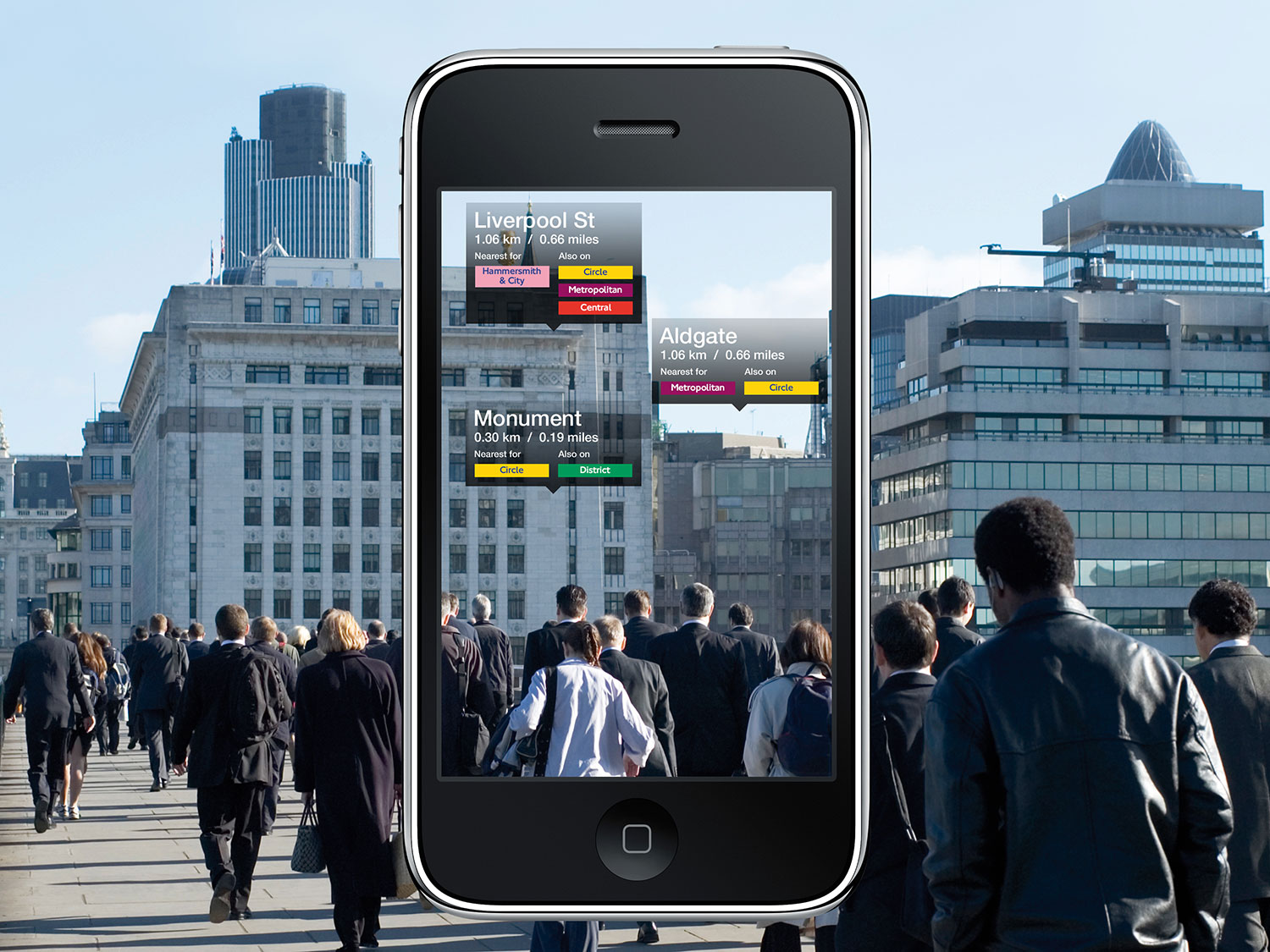Augmented reality bites
Smartphone data visualisation will force our digital and physical personae to co-exist.

The reviewer opts to use the application’s ‘famous people finder’, a service that purports to plot the known position of celebrities on a video feed of the surrounding area. The reviewer stares at the world through his phone screen, led by the circular icons that fill the emulated field of vision. After a number of failed location attempts in the city of Amsterdam, the camera zooms towards a window. We are presented with the unmistakable face of Brad Pitt wearing a pair of sunglasses and an exasperated expression. As he shakes his head and makes a retreat up some stairs, the reviewer and cameraman whoop and laugh. It’s an infectious and unexpected moment, but it also hints at the unforeseen social impact of this kind of technology. The amazement lies not in the fact that hunting down Brad Pitt is possible, but that it exists as a feature in a mobile phone application that is easy to use and cheap to obtain.
Despite sounding like the product of a sci-fi author’s spiralling imagination, ‘augmented reality’, or AR, is a fairly straightforward technology that has been around for a while; the name refers to the merging of a live video feed with computer generated imagery. This process might not seem so revolutionary: it has taken place for many years in televised football matches, where a graphic of the game’s score overlays a feed of the action. However, modern augmented reality takes this to another level of saturation, and operates on the premise that computer-generated graphics enhance a camera’s version of what we can see, providing us with a more useful, data-rich picture of the world around us.
Despite many mobile phones having the technical capacity to run augmented reality applications, it is the sheer ubiquity of the iPhone and the unprecedented popularity of Apple’s App Store that have made such innovation in the field of AR apps possible, and pushed it to the top of tech newsfeeds. With the release of the iPhone 3GS, AR could be on the cusp of mainstream popularity, and could soon become as everyday a technology as touch screens and GPS.
Recent implementations of AR, from the Brad Pitt-chasing Layar to the amenity-review service Yelp, represent the latest in tangible, useful convergences of the real world and the Internet. Many of these applications run with the ‘Google in 3D’ idea, offering local information but negating the need to search by presenting location-specific data that changes as the user moves, pivots and rotates.
One of the most interesting and startling application concepts to appear in recent weeks has been Augmented ID by The Astonishing Tribe. In the promo YouTube video released by the company, we see augmented reality technology used to create a kind of visual profile of people. As the phone points at an individual, their face is circled by a group of icons, mainly social network widgets and contact information, which realign along with their movements.
The service proposes to offer an immediate, one-click exchange of information by identifying the individual and then presenting their personal details as orbiting graphics. Developer Dan Gärdenfors sees a strong future for implementations of this kind of technology: “we believe that AR will become widely adopted when it works smoothly and allows ‘real life search’ without introducing layers of abstractions. By this we mean that information should be presented in a ‘zero click’ UI [user interface] where one does not have to switch applications or type URLs to access information about things one encounters in real life.”
Although Gärdenfors’ work revolves around the construction of this uniquely fluid user interface architecture, the ‘people search’ concept his company presents is one that has caught the collective imagination of the Internet community.
This seamless convergence of reality and social network information appears to be the next logical step forward for a world of access-anywhere Facebook and Twitter clients: placing virtual spaces amongst the artifacts and objects of real life, and giving them the illusion of physicality.
Within the processes of AR, our virtual and physical projections of personal identity are bound together: our Facebook Statuses or LastFM profiles become badges that we ‘wear’, gateways by which online persona meets real-life exterior. In Gärdenfors’ words: ‘What is very important in Augmented ID is the idea of taking control over the way other people can look at you. You “dress up” virtually, showing the information that you think is suitable for the context you are in.’
Of course, as with the incident of celebrity stalking made possible by Layar, the growth of augmented reality brings with it concerns related to both privacy and malicious use. But, as with social networking tools already in existence, Augmented ID’s concept revolves around user control. Being immediately identified and associated with our passions and interests is compelling on a human level: put simply, most of us want to be seen as we want to present ourselves and found by those that know us.

Share
Tweet this Share on Facebook